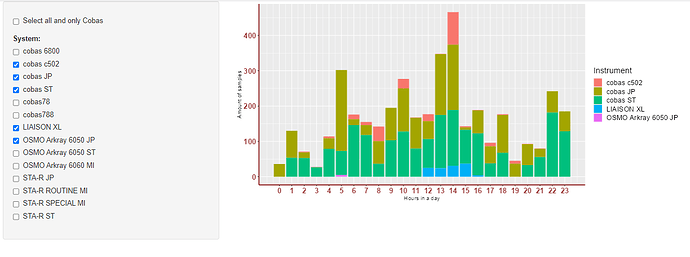Hi all
This question is a follow-up of this one:
https://forum.posit.co/t/how-to-let-count-the-checkboxgroup-in-a-cummulativ-manner-in-the-ggplot-on-shiny/151293/4
Here I wanted to make ggplot bar plot, when I clicked extra systems, they accumulate on the bar plot, but is it possible to have a stacked effect? Like if I clicked two systems, I can see that the bars are divided in two colors (with own labels), that represents the selected systems?
This is my server chunck:
#Add the choices to the dropdown menu, those choises are extracted from the file:
updateCheckboxGroupInput(session, 'system', label = NULL, choices = sort(unique(df1$InstrumentName)),
selected = 1, inline = FALSE)
#create interactive barplot:
output$barplot3 <- renderPlot({
if(input$all_cobas == TRUE) {
update_busy_bar(0)
df1_filtered <- df1[grep("cobas", df1$InstrumentName), ]
}
else {
df1_filtered <- df1[df1$InstrumentName %in% input$system,]
}
#Final amount of data rows/samples:
output$total_amount_of_samples_system <- renderText({nrow(df1_filtered)})
output$total_amount_of_samples_system_percentage <- renderText({scales::label_percent(accuracy = 0.01)(nrow(df1_filtered)/nrow(df1))})
update_busy_bar(33.33)
#Calculate the amount of Result-samples each hour:
hours_set <- hms(df1_filtered$ResultTime)
df2 <- as.data.frame(hours_set$hour)
df_aggr_Result <- aggregate(df2, by=list(df2$`hours_set$hour`), FUN = length)
#Renaming the columns:
names(df_aggr_Result)[names(df_aggr_Result) == "Group.1"] <- "hour"
names(df_aggr_Result)[names(df_aggr_Result) == "hours_set$hour"] <- "amount of samples"
update_busy_bar(66.66)
#Make sure that there are always 24 hours in a dataset, even if there are no counts for that hour:
all_h <- tibble(hour = 0:23)
df_plot = merge(x=all_h,y=df_aggr_Result,by="hour",all=TRUE)
df_plot[is.na(df_plot)] <- 0
#Create the labels in total amount and percentage:
df_plot <-
mutate(df_plot, p = df_plot$`amount of samples`/ sum(df_plot$`amount of samples`),
p = scales::label_percent(accuracy = 0.01)(p),
lab = paste(df_plot$`amount of samples`, p, sep = "\n"))
update_busy_bar(99.99)
update_busy_bar(100)
ggplot(df_plot, aes(x = df_plot$hour, y = df_plot$`amount of samples`)) +
geom_bar(fill = "#0073C2FF", stat = "identity") +
theme(axis.text.x = element_text(face = "bold", color = "#993333", size = 15),
axis.text.y = element_text(face = "bold", color = "#993333", size = 15),
axis.line = element_line(color = "#993333", size = 1)) +
scale_x_continuous(breaks=seq(0,23,1)) +
scale_y_continuous(limits = c(0,max(df_plot$`amount of samples`)+(0.1*max(df_plot$`amount of samples`)))) + #Add another 10% of the max to the y-scale to improve visual of the labels.
xlab("Hours in a day") + ylab("Amount of samples") +
geom_text(
label= if_else(df_plot$`amount of samples` > 0, df_plot$lab, ""),
vjust = 0,
nudge_y = 0.1,
check_overlap = F
)
})
Thanks in advance!
